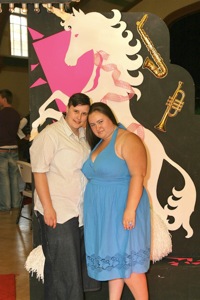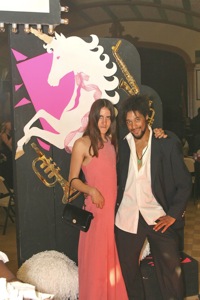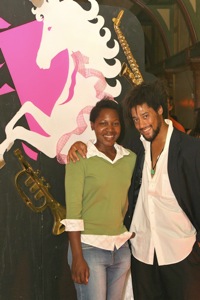feature
The Other Prom: young hearts in the right place
Published Thursday, 05-Jul-2007 in issue 1019
“My family kicked us out,” says Tiffany.
Tiffany, 20, is celebrating her third year at the Hillcrest Youth Center’s “Other Prom,” along with her transgender partner, AJ.
The prom, a dance for GLBT youth, now in its seventh year, draws up to 200 kids annually from around San Diego, says Naomi Wahler, program manager at Hillcrest Youth Center (HYC).
But while the kids come to the Other Prom to kick up their feet, it’s being “kicked out,” that they speak about. For many, it seems, coming out is near synonymous with being turned onto the streets.
Which is why the Other Prom is far more than a dance.
For, despite the heady music, the imaginatively attired kids cavorting down the “catwalk,” the two giant, black-lacquer pumas strung with lights and the chocolate fountain, the prom is, in essence, a homecoming – a place where GLBT youth find the love and acceptance they might miss elsewhere.
Tiffany, wearing a shiny, blue halter-top dress reminiscent of the 1950s, and AJ, boasting aviator glasses and an air of gentlemanly courtliness, say they were “kicked out” two years ago after telling their parents about their relationship.
But the pair, who met in a church playground when they were both 11, say their connection never faltered. “There’s always been something special there,” Tiffany says.
Still, they say they “tried to fight” the feeling for a couple of years.
“We both thought we were going to hell,” Tiffany explains.
Dealing with not only young love but also a society that teaches same-sex love is shameful is a struggle that sends many GLBT youth spiraling into drugs and depression. But Tiffany and AJ turned their experience to use helping others in the GLBT community. Now college students who share an apartment, they spend their spare time volunteering at HYC, where AJ will soon become a facilitator for a transgender-and-questioning-youth support group. Tiffany co-facilitates a coming-out group and is a member of the Center’s Marriage Equality Speakers Bureau.
Although Tiffany admits with a smile that her participation in the latter is largely motivated by her desire to marry AJ “yesterday,” it’s obvious that the pair’s activism is helping them to nurture a sense of identity and dignity.
Also a volunteer at HYC, is Joseph, a slight, young man wearing a black skull cap and flashy wrist jewelry.
“The prom is a wonderful opportunity to express yourself,” Joseph beams.
Why is self-expression the first thing he thinks about when he describes the prom? Because Joseph, who has lived in Hillcrest his entire life, did not know about the Hillcrest Youth Center until two months ago.
“I lived with my parents,” he explains, describing an environment he found restrictive but that his parents viewed as “protective.” They told Joseph to leave when he came out to them this spring.
Now Joseph says he’s expanding his horizons. “My date tonight is a drag queen,” he says. “That’s something I didn’t know about before. I was hiding before. But being out changed the way I talk to people, the way I walk, the way I dress. At my parents’ house, I had to wear button-down, nerdy T-shirts. Now I wear a lot of hats.”
A sudden smile outshines the rhinestone-studded dollar symbol hanging from his neck. “I have to go,” he says. “I left my hat in the car.” And with that he rushes giddily out of the room.
Alternative proms are no longer all that alternative. Over the past 15 years or so, they’ve grown from a scattered few events to a standard option in high schools and community centers across the country. As The Advocate reported in 2001, alternative proms “started making headlines 20 years ago, when Rhode Island teen Aaron Fricke won the legal right to take his boyfriend to the prom. Things have improved so much that these days it’s bigger news when schools refuse to allow same-sex couples to attend – ’though that certainly still happens.”
The Gay, Lesbian, and Straight Education Network and the American Civil Liberties Union encourage kids to challenge discriminatory prom policies. One such policy reversal occurred earlier this year when Fresno High School changed its district policy by adding 17-year-old Cinthia Covarrubias’ name to its ballot for prom king. The school’s previous policy allowed only males to run for the title.
Covarrubias’ campaign for the crown is believed to have been the first time an openly transgender person competed as prom royalty. It wasn’t the last, however. Fresno’s Roosevelt High School crowned Johhny Vera, 6-foot-4-inch (in heels), prom queen last May.
When kings can be queens and vice versa, one might wonder if alternative proms are still necessary. After all, as two young sprites at the Other Prom put it: “We don’t just go to the Other Prom. We go to any prom we can. We’re prom whores.”
But integration does not come so easily to everyone. At 21, shy, soft-spoken “Jessika with a ‘k’,” as she puts it, had never been to a prom before she came to this year’s Other Prom. “If I’d had more gay friends, maybe we could have gotten the courage to go together, but it’s really hard when you go with a group that doesn’t know you’re gay,” she says. “I wish I’d been able to come to an alternative prom when I was in high school.”
Many older GLBT community members share Jessika’s sentiment. The Los Angeles Gay & Lesbian Center held its ninth annual Senior Prom June 30. More than 100 people showed up to dance “cheek-to-cheek with a same-sex sweetheart,” the Center says.
In 2004, Brooklyn-based Black Skull Press published Kings & Queens: Queers at the Prom, by David Boyer. Boyer says his book is “a visual and oral history [that] goes to the queer heart of an American rite of passage and captures what it’s like to grow up gay, bi, trans or utterly confused.” It includes interviews with people from age 18 to 86, whose stories about their experiences at the prom cover the period from 1935 to 2003. The book is organized into sections titled, “Prom Queen,” “Drama Queen,” “Rebel” and “Black Sheep.” Read excerpts from the book at www.gayprom.com.
The Hillcrest Youth Center serves approximately 400 visits a month and has 35 volunteers. For more information about HYC’s activities and services, call 619-497-2920.
Sponsors of the Hillcrest Youth Center’s Other Prom include:
The Storefront
Metropolitan Community Church
Family Health Centers
PFLAG San Diego
J & N Jeweler’s
10, 000 RV
Storm International Flowers
|
|
Copyright © 2003-2025 Uptown Publications





